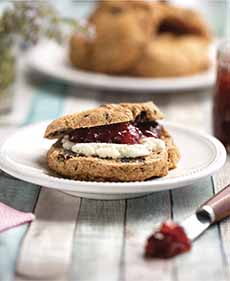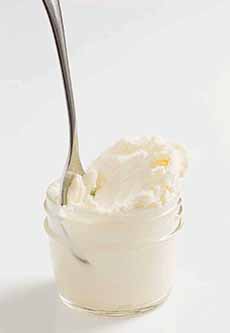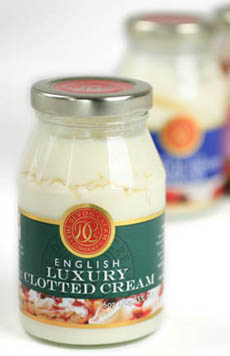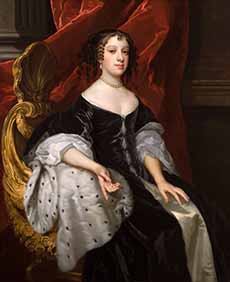What Is Cream Tea & The History (It’s National Cream Tea Day)
|
The last Friday in June is National Cream Tea Day, which begs the question: What is cream tea? Most Americans might think the obvious: It’s adding cream to your tea. But no. It’s what now is the practice of adding jam or preserves (traditionally strawberry) and clotted cream to scones, which are served with a pot of tea at tea time*. Long before tea arrived in England—and long before farmers created clotted cream—people put cream and jam on bread. The custom appears to have begun in the 11th century, and we posit that in addition to being delicious in itself, it may have been a way to use cream to soften yesterday’s bread. Tea from China arrived in the early 17th century, when Dutch traders from the British East India Company and the Dutch East India Company sailed home to Europe with chests of it. The precious leaves arrived in England in the 1650s. At first, tea was a novelty, served in London’s relatively new coffee houses. Few people drank it. The famous diarist Samuel Pepys wrote about his first tea experience in 1660: “…and afterwards I did send for a cup of tee (a China drink) of which I had never drank before, and went away.” That’s the first written documentation of tea drinking in England. Tea drinking got a boost in 1662 with the arrival of Portugal’s Catherine of Braganza, who became the wife of King Charles II. When her ship docked in Portsmouth on May 14, 1662, the travel-weary royal asked for a cup of tea. There was none to be had in Portsmouth. But among the goods she brought from Portugal was a chest of tea, the favorite drink of the Portuguese Court. Catherine popularized the drink at court among the British nobility, which was then embraced by the wealthy gentry. As more tea arrived from China and it became more affordable, it trickled down to the yeomanry, the middle class‡. But it was still so pricey, that it was kept in small locked tea chests, with the key carried on her person by the lady of the house. By the late 18th century, tea was considered the “national drink” of England [source]. Before tea arrived, there was coffee. But coffee was also a relatively recent arrival. Coffee became available in England, also via the Dutch traders, no later than the 16th century. According to a 1583 account, the first coffeehouse in England was opened in St. Michael’s Alley in Cornhill, the historic nucleus and financial center of modern London. In 1650 The Grand Cafe opened in Oxford. It’s still open today but as a wine bar. Oxford’s Queen’s Lane Coffee House, established in 1654, is still serving coffee today. By 1675, there were more than 3,000 coffeehouses throughout England. However, women were banned from them in England, and other countries as well [source]. According to this British wiki on coffee culture, “as their husbands, brothers, fathers and friends began to spend more and more time in coffeehouses,” they became something of a clubhouse, open to all…except women. “Although the lower and middle-class men were getting a chance to speak up and discuss current issues with scholars and journalists, women were still excluded from this vital part of society [ibid.]. Clotted cream is a thickened cream made by heating full-cream cow’s milk using steam or a water bath and then leaving it in shallow pans to cool slowly. As it cools, the cream content rises to the surface and forms “clots,” hence the name [source]. Some stories say that the Benedictine monks of Some give an earlier date: the 10th century. After their abbey was ransacked by Vikings in 997 C.E., the monks rebuilt their abbey with the help of Ordulf, Earl of Devon, who had founded the abbey in 974. The monks treated the workers were who were helping with the restoration to bread, clotted cream, and strawberry preserves [source]. Although its origin is uncertain, clotted cream is commonly associated with dairy farms in South West England, and in particular the counties of Devon and Cornwall. It was originally made by dairy farmers to reduce the amount of unused milk in the long era before refrigeration. It has long been disputed whether clotted cream originated in Devon or Cornwall, and which county makes it the best. Cornwall struck a blow in 1993 by applying for the term “Cornish clotted cream” to have a Protected Designation of Origin (P.D.O.) in the European Union. The designation was granted in 1998. Cornish clotted cream must be made from milk produced in Cornwall and have a minimum butterfat content of 55%. It is slightly yellow, due to the high carotene levels in the grass eaten by the cows. The 1658 cook book, The Compleat Cook had a recipe for “clouted cream” [source]. So, 364 years later, celebrate the day with your own cream tea. It’s a delicious breakfast, morning, or afternoon snack. *Afternoon tea originated as an elaborate snack served between the light lunches and late dinners served in the early 1800s. It is usually served between 3 p.m. and 4 p.m. It was a large spread with finger sandwiches and scones, cakes, macaroons, and other tidbits. Many people mistakenly call this “high tea,” which is not an elegant affair but a simple workman’s dinner (with a cup of tea, of course). Here’s more about afternoon tea, a tradition begun by a very hungry duchess. †What did the English drink before coffee? Beer, cider, milk. The eater supply was often polluted and disease-bearing, so only boiled water could be safely consumed. |
|
|
|
‡By the 18th century, the popularity of tea had grown so much that everyone wanted it. But it was still too expensive for people of modest means. Smugglers began bringing tea into the country illegally, to avoid the tea tax and thus sell it for less. Eventually, as it wa estimated that more illegal tea was brought into the country than legal tea, Prime Minister William Pitt the Younger slashed the tea tax from 119% to 12.5% in 1783. That eliminated the illegal smuggling trade, and with affordable tea, consumption skyrocketed [source].
|
||





